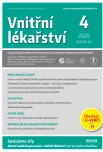Are changes in the blood count clinically useful marker of azathioprine dose?
Authors:
Vladimír Kojecký 1; Jan Matouš 2; Zdena Zádorová 2; Bohuslav Kianička 3; Aleš Hep 4
Authors‘ workplace:
Interní oddělení Krajské nemocnice T. Bati, a. s., Zlín, LF MU Brno
1; II. interní klinika 3. LF UK a FN Královské Vinohrady Praha
2; II. interní klinika LF MU a FN u sv. Anny Brno
3; Interní gastroenterologická klinika LF MU a FN Brno, pracoviště Bohunice
4
Published in:
Vnitř Lék 2020; 66(4): 67-70
Category:
Original Contributions
Overview
Introduction: The 6-thioguanine nucleotide (6-TGN) level, may be used to estimate dose-adequacy of azathioprine (AZA) therapy. 6-TGN test is not commercially available. The aim of the study was to determine whether a blood cell changes correlate also with the dose of AZA and may serve as a predictor of the dose adequacy (for MCV > 6 fl).
Methods: Retrospective, multicentre study in subjects with IBD treated with azathioprine. Demographic data, leukocyte, platelet counts, erythrocyte (MCV) and thrombocyte (MPV) volume, azathioprine dose, inflammatory activity in the 3rd, 6th and 12th months of treatment and presence of sideropenia were recorded.
Results: 103 subjects analysed. To increase the MCV by 6 fl, the AZA dose above 2 mg/kg is needed (p = 0.04). The MCV increases within 165 days (95% CI, 154–181 days, p = 0.002). Sideropenia has no impact on the MCV change. Number of leukocytes and thrombocytes decreases during treatment (p < 0.001). Change in their number as well as MPV, does not correlate with MCV change and is not affected by activity of the inflammation.
Conclusion: The MCV dynamics (> 6 fl within 6 months) is the only relevant indicator during AZA treatment. Changes in the number of leukocytes, platelets and their volume can not be used to assess the sufficiency of the AZA dose. Sideropenia has no impact on the dynamics of MCV.
Keywords:
azathioprine – blood test monitoring – inflammatory bowel diseases
Sources
1. Cuffari C, Hunt S, Bayless T. Utilisation of erythrocyte 6-thioguanine metabolite levels to optimise azathioprine therapy in patients with inflammatory bowel disease. Gut 2001; 48: 642–646.
2. Decaux G, Prospert F, Horsmans Y, et al. Relationship between red cell mean corpuscular volume and 6-thioguanine nucleotides in patients treated with azathioprine. J Lab Clin Med 2000; 135: 256–262.
3. Wright S. Clinical significance of azathioprine active metabolite concentrations in inflammatory bowel disease. Gut 2004; 53: 1123–1128.
4. Cuffari C, Hunt S, Bayless TM. Enhanced bioavailability of azathioprine compared to 6-mercaptopurine therapy in inflammatory bowel disease: correlation with treatment efficacy. Aliment Pharmacol Ther 2000; 14: 1009–1014.
5. Osterman MT, Kundu R, Lichtenstein GR, et al. Association of 6-thioguanine nucleotide levels and inflammatory bowel disease activity: a meta -analysis. Gastroenterology 2006; 130: 1047–1053.
6. Kopylov U, Battat R, Benmassaoud A, et al. Hematologic indices as surrogate markers for monitoring thiopurine therapy in IBD. Dig Dis Sci 2015; 60: 478–484.
7. Belaiche J, Dessger JP, Horsmans Y, et al. Therapeutic drug monitoring of azathioprine and 6-mercaptopurine metabolites in Crohn disease. Scand J Gastroenterol 2001; 36: 71–76.
8. D’Halluin PN, Tribut O, Branger B, et al. RBC 6-TGN and hematological parameters in patients with Crohn’s disease treated by azathioprine. Gastroenterol Clin Biol 2005; 29: 1264–1269.
9. Heerasing NM, Ng JF, Dowling D. Does lymphopenia or macrocytosis reflect 6-thioguanine levels in patients with inflammatory bowel disease treated with azathioprine or 6-mercaptopurine? Intern Med J 2016; 46: 465–469.
10. Sandborn WJ, Van O EC, Zins BJ, et al. An intravenous loading dose of azathioprine decreases the time to response in patients with Crohn’s disease. Gastroenterology 1995; 109: 1808–1817.
11. Kirschner BS. Safety of azathioprine and 6-mercaptopurine in pediatric patients with inflammatory bowel disease. Gastroenterology 1998; 115: 813–821.
12. Kapsoritakis AN, Koukourakis MI, Sfiridaki A, et al. Mean platelet volume: a useful marker of inflammatory bowel disease activity. Am J Gastroenterol 2001; 96: 776–781.
13. Lee MN, Kang B, Choi SY, et al. Relationship between azathioprine dosage, 6-thioguanine nucleotide levels, and therapeutic response in pediatric patients with IBD treated with azathioprine. Inflamm Bowel Dis 2015; 21: 1054–1062.
14. Douda T, Bureš J, Rejchrt S, et al. Mean platelet volume (MPV) in Crohn’s disease patients. Čas Lék Česk 2006; 145: 870–873.
15. Tekeoglu I, Gürol G, Harman H, et al. Overlooked hematological markers of disease activity in rheumatoid arthritis. Int J Rheum Dis 2016; 19: 1078–1082.
16. Hartmann LT, Alegretti AP, Machado ABMP, et al. Assessment of Mean Platelet Volume in Patients with Systemic Lupus Erythematosus. Open Rheumatol J. 2018; 12: 129–138.
Labels
Diabetology Endocrinology Internal medicineArticle was published in
Internal Medicine

2020 Issue 4
Most read in this issue
- Liver fibrosis
- Evaluation of surgical risk in patients with liver cirrhosis
- Microscopic polyangiitis
- Hyperuricemia in renal disease patients
